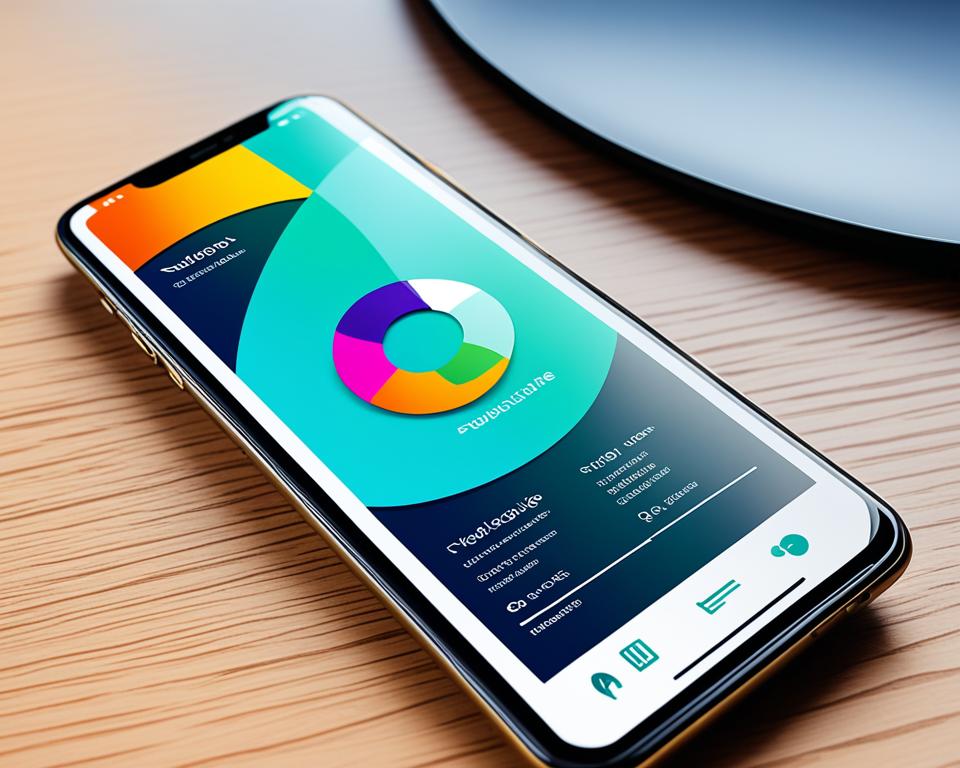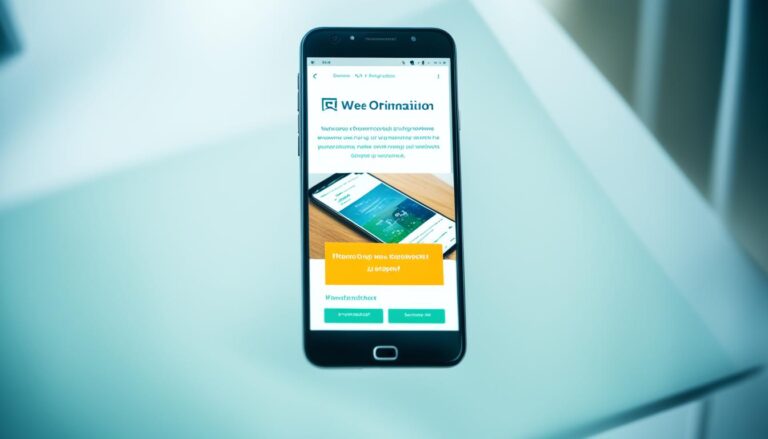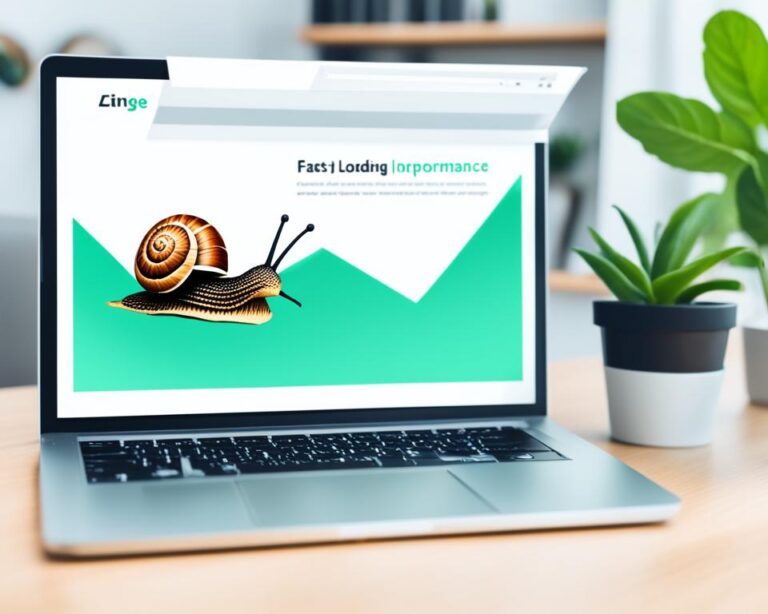Did you know that over 53% of global internet traffic now comes from mobile devices? With the rise of mobile usage, it has become essential for businesses to embrace mobile-friendly design to stay ahead in the digital landscape. But what exactly does it mean to have a mobile-friendly design, and why is it so important?
Mobile-friendly design refers to creating websites that adapt seamlessly to different screen sizes and devices. It involves implementing responsive web design, mobile optimization techniques, and user-friendly mobile interfaces. By prioritizing mobile-first design, businesses can improve their SEO rankings, enhance user experience, and reach a wider audience.
With such a significant percentage of internet traffic originating from mobile devices, it’s imperative to optimize your website for mobile usability and responsiveness. Neglecting mobile-friendly design could mean missing out on valuable opportunities and potential customers.
Key Takeaways:
- Over 53% of global internet traffic comes from mobile devices.
- Mobile-friendly design ensures seamless adaptation to different screen sizes and devices.
- Mobile-friendly design enhances SEO rankings and improves user experience.
- By embracing mobile-friendly design, businesses can reach a wider audience and stay competitive.
Understanding Mobile-Friendly Design
Mobile-friendly design is a crucial aspect of creating websites that cater to the needs of the modern digital landscape. With the majority of users accessing websites through their mobile devices, understanding and implementing mobile-friendly design principles is essential for a successful online presence. By optimizing your website for mobile devices, you can improve SEO, enhance user experience, increase conversion rates, and stay ahead of your competitors.
When we talk about mobile-friendly design, we are referring to the concept of creating websites that seamlessly adapt to different screen sizes and devices. This means that your website should look and function well, whether it is accessed on a desktop computer, a smartphone, a tablet, or any other mobile device. The goal is to provide an optimal user experience, regardless of the device being used.
The importance of mobile-friendly design cannot be overstated. As mentioned earlier, the majority of internet traffic now comes from mobile devices. If your website is not mobile-friendly, you risk alienating a significant portion of your audience and missing out on potential customers. Beyond reaching a wider audience, there are several other benefits to implementing mobile-friendly design:
- Boosting SEO: Search engines, like Google, prioritize mobile-friendly websites in their search results. A mobile-friendly design can improve your website’s ranking and visibility, ultimately driving more organic traffic to your site.
- Enhancing User Experience: Mobile-friendly websites are easier to navigate and interact with on smaller screens. By providing a seamless and intuitive user experience, you can keep visitors engaged, reduce bounce rates, and increase the likelihood of conversions.
- Staying Ahead of Competitors: In an increasingly mobile-centric world, businesses that prioritize mobile-friendly design gain a competitive edge. By catering to the needs and preferences of mobile users, you can differentiate your brand and stand out from the competition.
To truly understand the benefits of mobile-friendly design, it’s important to grasp the impact it can have on your website’s performance and overall success. By adopting a mobile-first mindset and prioritizing the needs of mobile users, you can create a website that not only looks great on any device but also delivers an exceptional user experience.
In the next section, we will dive deeper into the practical aspects of implementing mobile-friendly design. We will explore the differences between responsive and adaptive design, discuss various tools and technologies that facilitate mobile-friendly design, and highlight important SEO considerations. By the end of this article, you will have a comprehensive understanding of mobile-friendly design and be equipped to optimize your website for mobile success.
Implementing Mobile-Friendly Design
When it comes to implementing a mobile-friendly design, you have two main options: responsive design and adaptive design. Both approaches play a crucial role in ensuring that your website looks and functions seamlessly across different devices and screen sizes.
Responsive design allows your website’s layout to automatically adjust and adapt to fit any screen size, providing a consistent user experience. This design approach uses flexible grids and fluid proportion-based grids to ensure that your website looks great on both desktop and mobile devices. Whether a user is browsing on a large desktop monitor or a small smartphone screen, responsive design ensures that your content is easily readable and accessible.
Adaptive design, on the other hand, tailors the user experience to specific devices. This approach involves creating different versions of your website for different devices, optimizing each version for the best possible experience. Adaptive design considers factors such as screen size, device capabilities, and user context to provide a customized experience. While it requires creating multiple versions of your website, adaptive design allows for more control over the user experience on different devices.
When implementing a mobile-friendly design, there are several tools and technologies that can assist you in the process. Frameworks like Bootstrap provide a responsive grid system and pre-built components that make it easier to create a mobile-friendly website. Mobile testing tools like BrowserStack allow you to test your website’s performance and compatibility across different devices and browsers, ensuring a smooth experience for your users.
It’s important to consider SEO when implementing a mobile-friendly design. Proper meta tagging, including meta titles and descriptions, helps search engines understand the purpose and content of your pages. Optimizing your website’s URL structure and ensuring that your content is optimized for mobile viewing further enhances its SEO-friendliness. Tools like Google’s Mobile-Friendly Test can help you identify any issues that might impact your website’s mobile performance and guide you in making the necessary improvements.
Overall, implementing a mobile-friendly design is essential in today’s mobile-first digital landscape. Whether you choose responsive design or adaptive design, leveraging the right tools and technologies while considering SEO considerations will help you create a seamless and engaging user experience for your mobile audience.
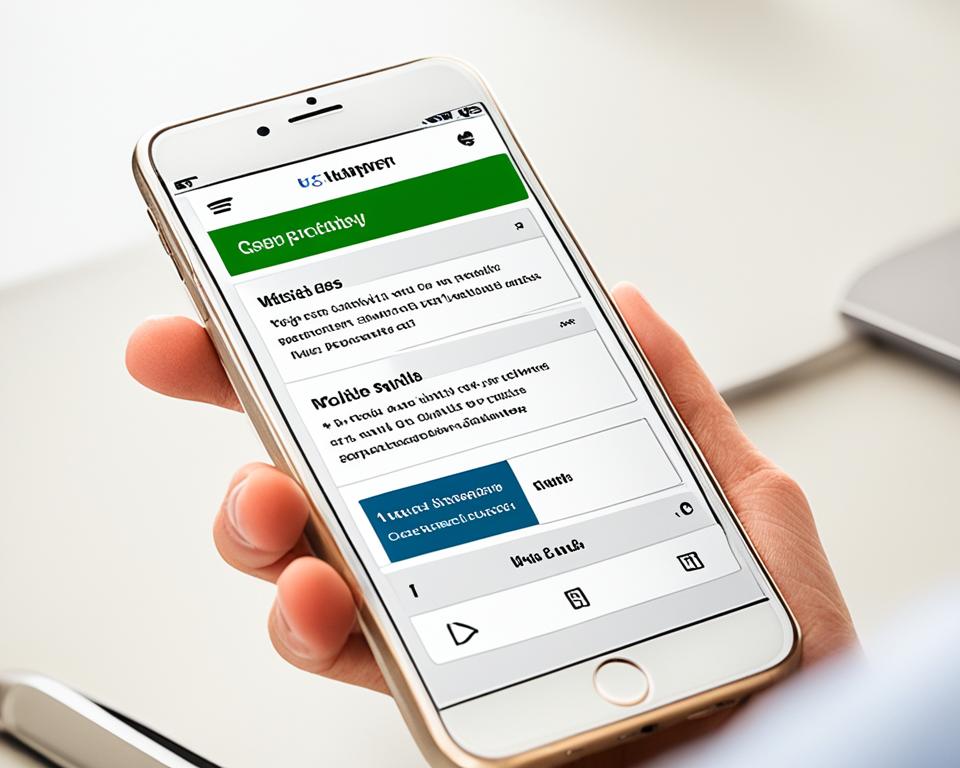
Next, we’ll explore some successful examples of mobile-friendly design and common mistakes to avoid in the implementation process.
Case Studies, Best Practices, Common Mistakes, and Industry Trends
When it comes to mobile-friendly design, there are successful examples that have set the industry standard. Apple, Airbnb, and Starbucks have all implemented mobile-friendly designs that prioritize user experience. These brands have achieved great success by seamlessly adapting their websites to different screen sizes and devices.
However, it is important to learn from common mistakes in mobile-friendly design in order to avoid them. Ignoring user behavior, failing to conduct thorough testing, and neglecting to create responsive designs are all pitfalls to steer clear of. By addressing these mistakes early on, you can ensure that your website provides a smooth mobile browsing experience.
Mobile-friendly design is not a one-size-fits-all approach. Different industries have specific guidelines and trends to consider. In the retail sector, seamless navigation and interactive displays are crucial for mobile-friendly design. In healthcare, mobile-friendly design focuses on easy access to medical information and personalized patient experiences. The education industry emphasizes the importance of mobile-friendly design that supports distance learning and engages students.
| Industry | Guidelines | Trends |
|---|---|---|
| Retail | Seamless navigation | Interactive displays |
| Healthcare | Easy access to medical information | Personalized patient experiences |
| Education | Support for distance learning | Engaging student experiences |
Staying up to date with industry-specific guidelines and trends is crucial for mobile-friendly design. By understanding the unique needs of different sectors, you can create websites that cater to the specific expectations and demands of your target audience.
By analyzing successful case studies, avoiding common mistakes, and following industry-specific guidelines and trends, you can ensure that your mobile-friendly design is effective and meets the needs of your users.
Integrating Content and Visuals
Mobile-friendly design requires a strategic approach to content and visuals. Crafting a well-thought-out content strategy for mobile-friendly design is essential to engage your mobile audience effectively. Here are some key considerations:
- Keep it concise: Mobile users have limited attention spans and tend to skim through content. Opt for short paragraphs, bullet points, and subheadings to make your content easily scannable.
- Align with mobile browsing habits: Understand how users interact with mobile devices and tailor your content accordingly. Use clear and straightforward language, highlight important information, and ensure seamless navigation.
- Optimize visuals for mobile: Visual optimization for mobile-friendly design plays a vital role in engaging users. Use high-quality images and videos that load quickly on mobile devices. Compress and optimize images to maintain good performance without sacrificing visual appeal.
- Accessibility and inclusivity: Consider the needs and preferences of individuals with disabilities. Ensure your website follows accessible design practices, such as providing alternative text for images and using color contrast that is easy to read.
To further illustrate the importance of integrating content and visuals, take a look at this example:
| Company | Description |
|---|---|
| Company XYZ, a leading e-commerce platform, successfully integrates content and visuals in its mobile-friendly design. By prioritizing high-quality product images, user-generated content, and visually appealing layouts, they create an immersive and engaging mobile shopping experience. This focus on visual optimization improves user engagement and drives conversions. |
Future Considerations and Technologies
Staying ahead in mobile design requires considering future trends and technologies. Optimizing for voice search, integrating augmented reality and virtual reality experiences, and preparing for the impact of 5G technology are crucial for maintaining a cutting-edge mobile design.
Voice Search Optimization
With the increasing popularity of voice assistants like Siri, Alexa, and Google Assistant, optimizing for voice search is essential for mobile design. Voice search optimization involves understanding natural language queries and tailoring content to match user intent. By incorporating relevant keywords and adopting a conversational tone, you can improve your website’s visibility and accessibility for voice searches.
Augmented Reality and Virtual Reality in Mobile Design
Augmented reality (AR) and virtual reality (VR) are revolutionizing the mobile design landscape, offering immersive and interactive experiences for users. By integrating AR and VR elements into your mobile design, you can provide unique and engaging content. Whether it’s showcasing products in AR, creating virtual tours, or enhancing gaming experiences, leveraging AR and VR technologies can differentiate your mobile design and captivate your audience.
5G Technology and Its Impact on Mobile Browsing
As 5G technology continues to roll out, it will significantly impact mobile browsing experiences. With faster download and upload speeds, lower latency, and increased network capacity, 5G opens up new possibilities for mobile design. Websites can load faster, deliver richer media content, and provide seamless streaming experiences. To leverage the benefits of 5G technology, mobile designs should be optimized to take advantage of its capabilities and deliver exceptional user experiences.
| Benefits of Future Mobile Design Technologies | Examples |
|---|---|
| Enhanced user engagement and interactivity | Augmented reality-powered shopping experiences on leading retail apps. |
| Improved accessibility and inclusivity | Voice-enabled interfaces for visually impaired users. |
| Seamless integration of real and virtual worlds | Virtual reality travel experiences providing 360-degree views of destinations. |
| Increased website performance and faster load times | Websites loading instantly with 5G-powered networks. |
By embracing voice search optimization, augmented reality, virtual reality, and understanding the potential of 5G technology, your mobile design can thrive in an ever-evolving digital landscape.
Improving Your Site’s Mobile Load Time
A fast site load time is crucial for a positive mobile user experience. When browsing on their mobile devices, users expect quick access to information and a seamless browsing experience. A slow-loading site can lead to frustration and high bounce rates, ultimately affecting user engagement and conversions.
One valuable tool to assess and improve site load time for mobile is Google PageSpeed Insights. This tool provides insights and recommendations to help optimize your website’s performance and loading speed on mobile devices. It analyzes various factors that impact site speed, including image compression, server response time, and resource caching.
Here are some key strategies you can implement to improve your site’s mobile load time:
- Compress and Optimize Images: Large and unoptimized images can significantly slow down your site. Use tools to compress images without sacrificing quality and consider lazy loading techniques to only load images when they are visible to the user.
- Minimize HTTP Requests: Each file (e.g., HTML, CSS, JavaScript) requested by a user adds to the load time. Minimize the number of HTTP requests by combining and minifying files when possible.
- Utilize Content Delivery Networks (CDNs): CDNs cache your website’s static files in multiple servers distributed globally. This reduces the distance between the user and the server, resulting in faster load times.
Implementing these strategies will help optimize your site’s load time for mobile devices, leading to improved user experience and increased engagement. Remember to regularly monitor and analyze your site’s performance using tools like Google PageSpeed Insights to identify any areas for further optimization.

Optimizing Images for Mobile Load Time
Images play a crucial role in mobile web design, but they can also significantly impact load times if not optimized properly. Here are some tips to ensure your images are optimized for mobile:
- Use appropriate image formats: JPEG is recommended for photographs, while PNG is best for graphics and logos.
- Resize images to the appropriate dimensions: Avoid displaying large images on small screens to minimize bandwidth usage.
- Compress images: Use image compression tools or plugins to reduce file sizes without sacrificing quality.
- Implement lazy loading: Load images only when they are visible to the user, reducing the initial load time.
“Optimizing images for mobile load time is crucial for delivering a seamless browsing experience to your mobile users. By implementing these best practices, you can minimize load times and ensure your website performs optimally on mobile devices.” Website Optimization Expert
Integrating Responsive Design for Mobile Optimization
Responsive design is crucial for optimizing your website for mobile devices. With the increasing use of smartphones and tablets, it is essential to provide a seamless user experience across different screen sizes and resolutions. By implementing responsive design, your website will automatically adjust its layout and content to fit the device it is being viewed on, ensuring that users can easily navigate and interact with your site.
One of the key benefits of responsive design is improved user experience. Mobile users have different browsing habits and preferences compared to desktop users. Responsive design allows you to create a mobile-friendly interface that is easy to navigate, read, and interact with, enhancing overall user satisfaction and engagement.
Moreover, responsive design can positively impact your search engine rankings. Google and other search engines prioritize mobile-friendly websites in their search results, as they understand that a significant portion of users access the internet through mobile devices. By implementing responsive design, you are signaling to search engines that your website is optimized for mobile, which can lead to better visibility and higher rankings.
“Implementing responsive design allows websites to adapt to different screen sizes and resolutions, making browsing easy and visually appealing for mobile users.”
Integrating responsive design also future-proofs your website. With the constant evolution of devices and screen sizes, responsive design ensures that your website remains visually appealing and functional on any device that emerges in the future. This saves you from the hassle and cost of having to redesign your website every time a new device or screen size becomes popular.
To illustrate the impact of responsive design, take a look at the following table:
| Website | Desktop Traffic | Mobile Traffic |
| Your Website (Before Responsive Design) | 70% | 30% |
| Your Website (After Responsive Design) | 50% | 50% |
The table above clearly demonstrates the impact of responsive design on mobile traffic. By implementing responsive design, your website’s mobile traffic increased from 30% to 50%, reflecting a more balanced user distribution between desktop and mobile devices. This increase in mobile traffic indicates that responsive design successfully optimized your website for mobile users, resulting in a better user experience and increased engagement.
By integrating responsive design, you enable your website to adapt and cater to the needs of mobile users, resulting in improved user experience, increased engagement, and better search engine rankings. It is a fundamental approach to optimizing your website for the evolving landscape of mobile devices.
Mobile SEO Best Practices
When it comes to optimizing your website for mobile devices, there are several best practices you need to keep in mind. These practices are designed to improve your site’s visibility in mobile search results and enhance the user experience for mobile users. By implementing these strategies, you can ensure that your website is mobile-friendly, accessible, and relevant to local audiences.
Improve Site Load Time
One of the key factors in mobile SEO is the load time of your website. Mobile users have little patience for slow-loading sites, and a delay of just a few seconds can lead to high bounce rates. To improve your site’s load time, consider compressing and optimizing images, minimizing HTTP requests, and utilizing content delivery networks. By making these optimizations, you can provide a faster and smoother user experience for mobile visitors.
Integrate Responsive Design
Responsive design is critical for mobile optimization. It allows your website to adapt to different screen sizes and resolutions, ensuring that it looks and functions well on any device. With responsive design, you can create a seamless user experience that is visually appealing and easy to navigate for mobile users. This not only enhances the user experience but also increases engagement and improves search engine rankings.
Provide a Positive User Experience
User experience plays a crucial role in mobile SEO. Mobile users expect a seamless and enjoyable browsing experience, and factors such as easy navigation, clear calls to action, and intuitive design are essential. To provide a positive user experience, optimize your website’s layout for mobile screens, ensure that buttons and links are easy to tap, and minimize the use of intrusive pop-ups that may hinder navigation or disrupt the user experience.
Optimize for Local Searches
With the increasing use of mobile devices for local searches, optimizing your website for local SEO is crucial. This involves incorporating relevant local keywords and location-specific information throughout your site’s content. Additionally, make sure that your business information is accurate and consistent across all online platforms, such as directories and review sites. By doing so, you can increase your visibility in local search results and attract more local customers.
By following these mobile SEO best practices, you can ensure that your website is optimized for mobile devices, provides a positive user experience, and ranks well in mobile search results. Remember to regularly monitor your site’s performance and make adjustments as needed to stay ahead of the competition.
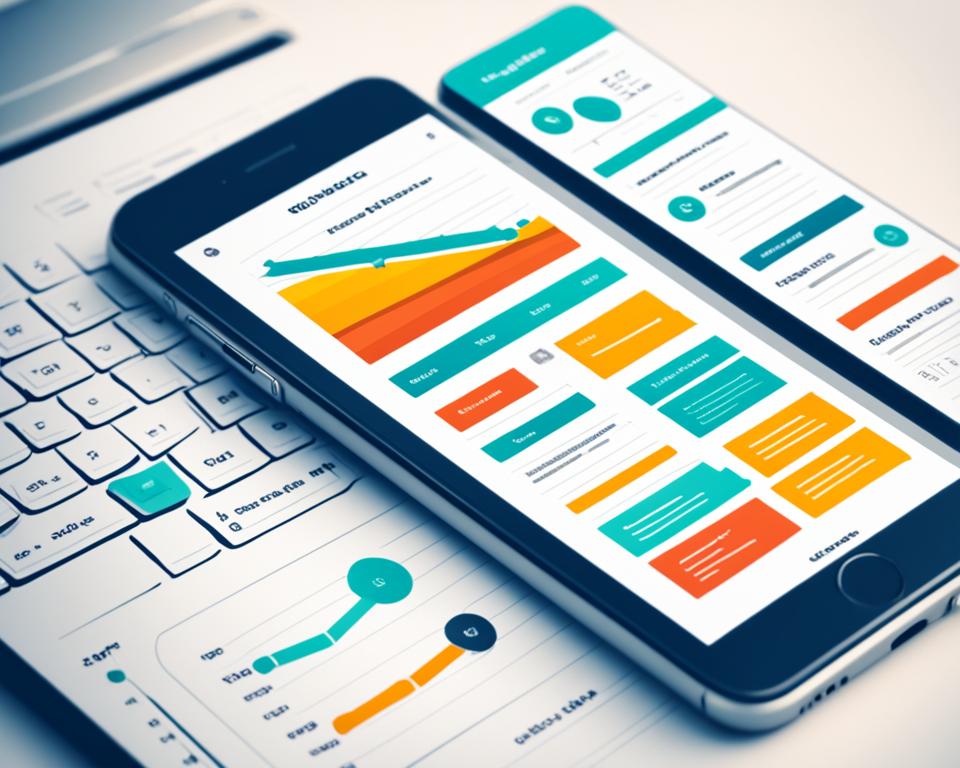
Conclusion
Mobile-friendly design is a critical aspect of succeeding in today’s digital landscape. With the majority of internet traffic originating from mobile devices, it is essential for businesses to optimize their websites for mobile users. Mobile optimization not only provides a positive user experience but also improves SEO and increases engagement and conversions.
By implementing mobile-friendly strategies, businesses can tap into a wider audience and stay ahead of their competitors. Websites that are designed to adapt seamlessly to different screen sizes and devices attract more visitors and keep them engaged, leading to higher conversion rates. Moreover, mobile optimization allows businesses to rank higher in search engine results, attracting organic traffic and boosting their online visibility.
Ensuring a mobile-friendly design also means prioritizing user experience. By providing a responsive and intuitive mobile interface, businesses can enhance customer satisfaction, establish credibility, and build lasting relationships with their audience. In addition, mobile optimization enables businesses to leverage the power of mobile technology, such as location-based marketing and personalized experiences, to deliver targeted and relevant content to mobile users.
In conclusion, mobile-friendly design and optimization are indispensable in today’s digital era. By embracing mobile-first approaches and implementing mobile-friendly strategies, businesses can unlock a wealth of opportunities, reach a broader audience, and position themselves for long-term success in the ever-evolving digital landscape.

